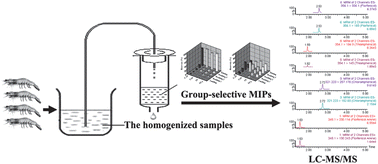Characterisation and application of molecularly imprinted polymers for group-selective recognition of antibiotics in food samples
Abstract
Group-selective molecularly imprinted

Maintenance work is planned for Wednesday 1st May 2024 from 9:00am to 11:00am (BST).
During this time, the performance of our website may be affected - searches may run slowly and some pages may be temporarily unavailable. If this happens, please try refreshing your web browser or try waiting two to three minutes before trying again.
We apologise for any inconvenience this might cause and thank you for your patience.
* Corresponding authors
a
Key Laboratory of Applied Technology of Marine Biology, School of Marine Sciences, Ministry of Education, Ningbo University, 818 Fenghua Road, Ningbo 315211, P.R. China
E-mail:
sxzsal78@yahoo.com.cn
Fax: +86-574-87608347
Tel: +86-574-87600551
b Laboratory of Food Analysis, Faculty of Pharmaceutical Sciences, Ghent University, Harelbekestraat 72, 9000 Ghent, Belgium
Group-selective molecularly imprinted

 Please wait while we load your content...
Something went wrong. Try again?
Please wait while we load your content...
Something went wrong. Try again?
X. Shi, S. Song, A. Sun, J. Liu, D. Li and J. Chen, Analyst, 2012, 137, 3381 DOI: 10.1039/C2AN35213C
To request permission to reproduce material from this article, please go to the Copyright Clearance Center request page.
If you are an author contributing to an RSC publication, you do not need to request permission provided correct acknowledgement is given.
If you are the author of this article, you do not need to request permission to reproduce figures and diagrams provided correct acknowledgement is given. If you want to reproduce the whole article in a third-party publication (excluding your thesis/dissertation for which permission is not required) please go to the Copyright Clearance Center request page.
Read more about how to correctly acknowledge RSC content.
 Fetching data from CrossRef.
Fetching data from CrossRef.
This may take some time to load.
Loading related content
